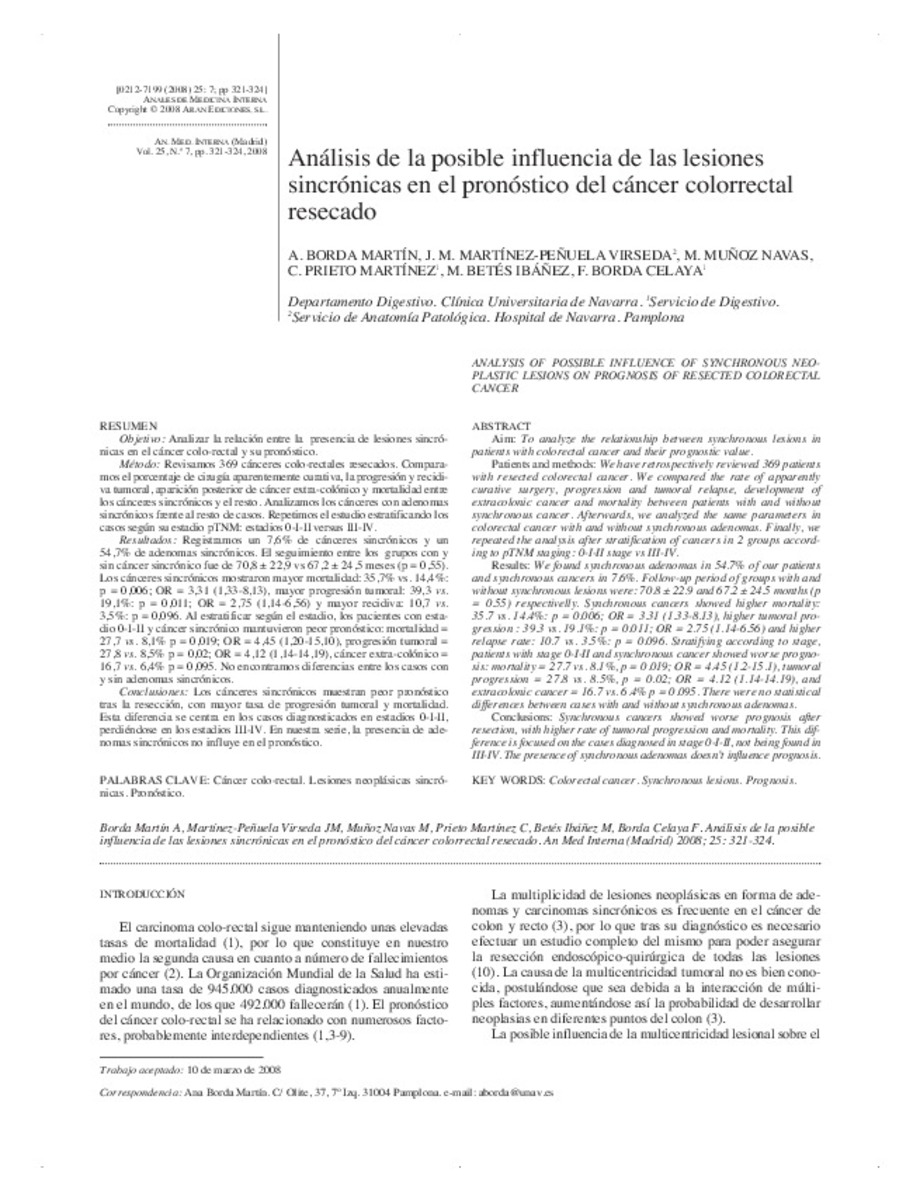Full metadata record
| DC Field | Value | Language |
|---|---|---|
| dc.creator | Borda-Martin, A. (Ana) | - |
| dc.creator | Martinez-Peñuela, J.M. (J.M.) | - |
| dc.creator | Muñoz-Navas, M. (Miguel) | - |
| dc.creator | Prieto-Martínez, C. (Carlos) | - |
| dc.creator | Betes, M.T. (María Teresa) | - |
| dc.creator | Borda-Celaya, F. (F.) | - |
| dc.date.accessioned | 2012-06-12T21:41:58Z | - |
| dc.date.available | 2012-06-12T21:41:58Z | - |
| dc.date.issued | 2008 | - |
| dc.identifier.citation | Borda Martin A, Martinez-Penuela JM, Munoz Navas M, Prieto Martinez C, Betes Ibañez M, Borda Celaya F. Análisis de la posible influencia de las lesiones sincrónicas en el pronóstico del cáncer colorrectal resecado. An Med Interna 2008 Jul;25(7):321-324. | es_ES |
| dc.identifier.issn | 0212-7199 | - |
| dc.identifier.uri | https://hdl.handle.net/10171/22545 | - |
| dc.description.abstract | Aim: To analyze the relationship between synchronous lesions in patients with colorectal cancer and their prognostic value. Patients and methods: We have retrospectively reviewed 369 patients with resected colorectal cancer. We compared the rate of apparently curative surgery, progression and tumoral relapse, development of extracolonic cancer and mortality between patients with and without synchronous cancer. Afterwards, we analyzed the same parameters in colorectal cancer with and without synchronous adenomas. Finally, we repeated the analysis after stratification of cancers in 2 groups according to pTNM staging: 0-I-II stage vs III-IV. Results: We found synchronous adenomas in 54.7% of our patients and synchronous cancers in 7.6%. Follow-up period of groups with and without synchronous lesions were: 70.8 ± 22.9 and 67.2 ± 24.5 months (p = 0.55) respectivelly. Synchronous cancers showed higher mortality: 35.7 vs. 14.4%: p = 0.006; OR = 3.31 (1.33-8.13), higher tumoral progression : 39.3 vs. 19.1%: p = 0.011; OR = 2.75 (1.14-6.56) and higher relapse rate: 10.7 vs. 3.5%: p = 0.096. Stratifying according to stage, patients with stage 0-I-II and synchronous cancer showed worse prognosis: mortality = 27.7 vs. 8.1%, p = 0.019; OR = 4.45 (1.2-15.1), tumoral progression = 27.8 vs. 8.5%, p = 0.02; OR = 4.12 (1.14-14.19), and extracolonic cancer = 16.7 vs. 6.4% p = 0.095. There were no statistical differences between cases with and without synchronous adenomas. Conclusions: Synchronous cancers showed worse prognosis after resection, with higher rate of tumoral progression and mortality. This difference is focused on the cases diagnosed in stage 0-I-II, not being found in III-IV. The presence of synchronous adenomas doesn’t influence prognosis. | es_ES |
| dc.language.iso | spa | es_ES |
| dc.publisher | Aran | es_ES |
| dc.rights | info:eu-repo/semantics/openAccess | es_ES |
| dc.subject | Colorectal cancer | es_ES |
| dc.subject | Synchronous lesions | es_ES |
| dc.subject | Prognosis | es_ES |
| dc.title | Análisis de la posible influencia de las lesiones sincrónicas en el pronóstico del cáncer colorrectal resecado | es_ES |
| dc.title.alternative | Analysis of possible influence of synchronous neoplastic lesions on prognosis of resected colorectal cancer | es_ES |
| dc.type | info:eu-repo/semantics/article | es_ES |
| dc.relation.publisherversion | http://scielo.isciii.es/pdf/ami/v25n7/original1.pdf | es_ES |
| dc.type.driver | info:eu-repo/semantics/article | es_ES |
Files in This Item:
Statistics and impact
Items in Dadun are protected by copyright, with all rights reserved, unless otherwise indicated.






